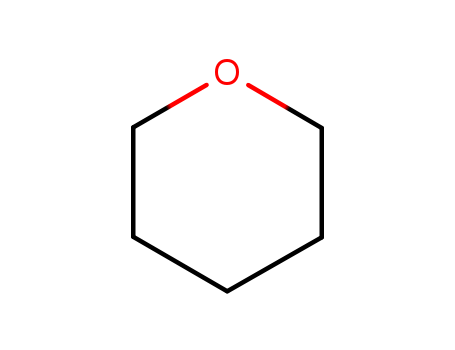10.1055/s-0031-1290379
The research focuses on an alternative synthetic route towards the tetrahydropyran core of psymberin, a marine cytotoxin with high cytotoxicity against various cancer cell lines. The key steps involve a catalytic enantioselective Mukaiyama aldol reaction and a syn reduction, which rapidly assemble a γ-lactone precursor for the central fragment of the natural product. The reactants used include silyl enol ether 3 and ethyl glyoxalate (4), with titanium(IV)/6,6′-dibromobinaphthol catalyst D system employed for the aldol reaction. The experiments utilized various catalytic systems and conditions to optimize enantioselectivity and yield, with analyses conducted through techniques such as HPLC, NMR, and IR spectroscopy to confirm the structure and purity of the synthesized compounds.
10.1021/jo00288a047
The research focuses on the development of a new strategy for the construction of polyether antibiotic substructural units, such as spiroketals, tetrahydrofurans, and tetrahydropyrans. The strategy involves a tandem 1,3-dipolar cycloaddition and electrophilic cyclization sequence, which proceeds via the intermediacy of an isoxazoline. The method was found to be versatile and provided a unique exploitation of the control elements in dipolar cycloaddition and electrophilic cyclization chemistry. Key chemicals used in the process include various isoxazolines (e.g., la, lb, lc, Id, le, lg, lh), triphenylacetonitrile oxide, iodine, and different dienes such as 1,5-hexadiene, 1,7-octadiene, and 1,9-decadiene, among others. The research concluded that this approach could be a general and versatile route to the cyclic ether substructural units common to polyether antibiotics, with the ability to control stereoselectivity in the electrophilic cyclization step.
10.1055/s-0030-1260232
The study presents an innovative one-pot synthetic method involving sequential isomerization, Wittig olefination, and hydrogenation of primary allylic alcohols. The process begins with the isomerization of allylic alcohols to aldehydes using Pd(OH)2 as the catalyst. Subsequently, stabilized Wittig ylides are added to the reaction mixture to perform the olefination, converting the aldehydes into α,β-unsaturated carbonyl derivatives. In the final step, additional Pd(OH)2 catalyst is introduced, and the reaction mixture is subjected to hydrogenation, resulting in the formation of saturated carbonyl derivatives. The study also explores a variation of this process involving an oxa-Michael addition reaction, yielding tetrahydropyran derivatives with high diastereoselectivity. This method offers an efficient and environmentally favorable approach to synthesizing complex organic molecules from simple allylic alcohols, with potential applications in the synthesis of pharmaceuticals, agrochemicals, and other fine chemicals.
10.1016/S0008-6215(00)90291-X
The study investigates the reaction of various 3-hetero-1,5-dialdehydes with tert-butyl cyanoacetate. The chemicals involved include thiodiglycolaldehyde and diglycolaldehyde, which react with tert-butyl cyanoacetate to yield derivatives of tetrahydrothiopyran and tetrahydropyran, respectively. Other dialdehydes with furan nuclei at the cy-position, such as a-(S)-(3-ethoxycarbonyl-2-methylfur-5-yl)diglycolaldehyde and a-(S)-(3-acetyl-2-methylfur-5-yl)diglycolaldehyde, produce D-xylo and L-arabino C-pyranosyl derivatives. Additionally, a-(S)-methoxy-a’-(R)-hydroxymethyldiglycolaldehyde leads to D-gluco and D-manno glycosides. The reactions are catalyzed by piperidine and carried out in aqueous 1,4-dioxane at room temperature. The products are isolated using column chromatography, and their structures are determined through elemental analysis and spectroscopic data. The study aims to synthesize 3-deoxy-C-glycosyl derivatives and 3-deoxyglycosides branched at C-3, with the relative proportions of products depending on the reaction time and molar ratios of the reactants.
10.1002/anie.201201323
The study explores a novel synthetic approach to construct the complex ring structures found in bryostatins, a class of marine natural products with significant biological activity. The key innovation is the use of bis(silyl) homoallylic alcohols, which act as bifunctional synthons in a Prins cyclization reaction with aldehydes to form cis-tetrahydropyrans with a geometrically defined exocyclic vinylsilane. The bis(silyl) group plays a dual role: one silyl group acts as an allylsilane facilitating the cyclization to form the tetrahydropyran ring, while the other acts as a vinylsilane, which can be further transformed into a methyl enoate with retention of configuration. The study demonstrates excellent cis and Z selectivity in the cyclization process, yielding the desired products with high efficiency and selectivity. This method was successfully applied to synthesize ring B of the bryostatins, highlighting the potential of bis(silyl) compounds in constructing complex natural product architectures.



 F,
F, Xi
Xi


